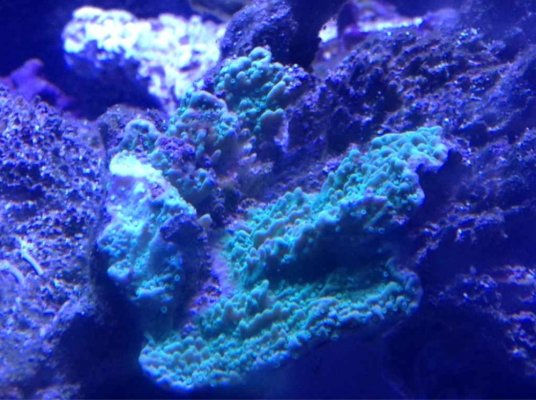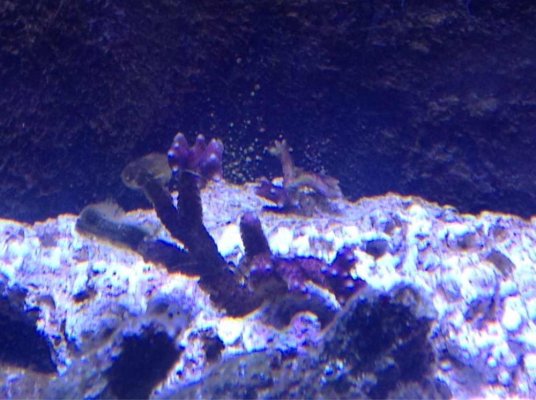You are using an out of date browser. It may not display this or other websites correctly.
You should upgrade or use an alternative browser.
You should upgrade or use an alternative browser.
New sps dying
- Thread starter Shanetweedz
- Start date
The friendliest place on the web for anyone with an interest in aquariums or fish keeping!
If you have answers, please help by responding to the unanswered posts.
If you have answers, please help by responding to the unanswered posts.
Sniperhank
Giant Clam Addict
You don't want anything growing on SPS. It will overwhelm and kill it. Sometimes damage like such won't let them recover. The browning of the montipora is tissue recession and is not good.
Mebbid
Aquarium Advice Addict
What are the parameters of your tank?
Shanetweedz
Aquarium Advice Freak
Ammonia0
Nitrite 0
Nitrate5
Calcium 450
Alk 12
Sent from my iPad using Aquarium Advice
Nitrite 0
Nitrate5
Calcium 450
Alk 12
Sent from my iPad using Aquarium Advice
Sniperhank
Giant Clam Addict
I'd like to see a phosphate test from a quality kit. The algae I see reminds me of my tank and its phosphate issues.
Shanetweedz
Aquarium Advice Freak
Im running gfo
What test kit would you recommend I heard most are junk
Sent from my iPad using Aquarium Advice
What test kit would you recommend I heard most are junk
Sent from my iPad using Aquarium Advice
Sniperhank
Giant Clam Addict
I like my hanna checkers, but Red Sea is quality stuff.
Shanetweedz
Aquarium Advice Freak
The birds nest is bleaching at the bottom of the base anything I can do to save it?
Sent from my iPad using Aquarium Advice
Sent from my iPad using Aquarium Advice
Sniperhank
Giant Clam Addict
If there is still algae on it, remove it. You can try fragging it above the tissue recession.
Reefer James
Aquarium Advice Freak
The birds nest is bleaching at the bottom of the base anything I can do to save it?
Sent from my iPad using Aquarium Advice
This is pretty common of under lit tanks. Try to make sure the birds nest tips are pointed and growing towards your tip. This will place it more similar to how it was in it's old location.
I like the idea of fragging it. High flow really helps, but not the point of blowing the polyps off. They should be extended and moving constantly though.
Istrom
Aquarium Advice FINatic
Sniperhank is right, the only time I've ever seen a SPS come back from recession and algae growing over it was with my montipora setosa, and I really think I just got extremely lucky.
Breakthecycle2
Aquarium Advice FINatic
My tank is only 3 months old and I went through (still a little actually) a cyano problem. I did the lights off thing and at times only kept the blues on for a few hours. My SPS started turning brown. Once I kept the lights on the regular schedule, they started coming back. That being said, what REALLY helped was I started doing daily dosing of Red Sea Reef Energy and Reef Colors. ALL my coral, within 10 days, started showing the most incredible colors. The greens and blues in particular are very crisp.
My tank is only 3 months old and I went through (still a little actually) a cyano problem. I did the lights off thing and at times only kept the blues on for a few hours. My SPS started turning brown. Once I kept the lights on the regular schedule, they started coming back. That being said, what REALLY helped was I started doing daily dosing of Red Sea Reef Energy and Reef Colors. ALL my coral, within 10 days, started showing the most incredible colors. The greens and blues in particular are very crisp.
While these supplements may be good for and established tank, that has nutrients and stability under control, they can add to excess pollution and certain elements being thrown out of whack.
Reef colors and energy should be used and dosed according to the elements tested for those each individual items.
(Example: if your dosing "A" and not testing for iodine, you could be adding iodine too excess).
3 months is not going to be too terribly stable.
Cyano being present means excessive PO4 & or NO3, reef energy is adding to that.
Reefer James
Aquarium Advice Freak
Biggest thing with SPS and tissue recession is around flow or light. anything else will usually just change it's color.
With SPS flow can start to be a factor the next day. If you buy a colony used to rapid water flow (which is where we keep SPS in stores) and you put it in a tank with one no flow it's going to recede.
SPS requires owners to realize these animals come from a coral reef. I believe acropora can withstand up to 20lbs of water pressure with correct calcium skeleton. If you can't see the polyps constantly moving it's not enough flow haha
With SPS flow can start to be a factor the next day. If you buy a colony used to rapid water flow (which is where we keep SPS in stores) and you put it in a tank with one no flow it's going to recede.
SPS requires owners to realize these animals come from a coral reef. I believe acropora can withstand up to 20lbs of water pressure with correct calcium skeleton. If you can't see the polyps constantly moving it's not enough flow haha
Alk swings is a major contributor as well I find.
Temperature, alk, ph swinging drastically can all be factored into stn / rtn.
Sometimes they just do because they're sensitive little.....
Sent from my iPhone using Aquarium Advice
Temperature, alk, ph swinging drastically can all be factored into stn / rtn.
Sometimes they just do because they're sensitive little.....
Sent from my iPhone using Aquarium Advice
Reefer James
Aquarium Advice Freak
I mean for all sake and purposes alkalinity is just a buffer. It's a matter of how easily the pH can swing.
Typically there's not enough waste for low alkalinity to be an issue in aquaria. What would be more likely is if kh was low, calcification has drawn magnesium down and now calcification can not even occur and then death is seen.
Temp will hurt you quickly that is true but we're talking 82+ for a long period of time. Salinity as well.
Gosh the more we explain sps the harder it sounds haha..
Typically there's not enough waste for low alkalinity to be an issue in aquaria. What would be more likely is if kh was low, calcification has drawn magnesium down and now calcification can not even occur and then death is seen.
Temp will hurt you quickly that is true but we're talking 82+ for a long period of time. Salinity as well.
Gosh the more we explain sps the harder it sounds haha..
Reefer James
Aquarium Advice Freak
True...true!
Just alkalinity is easiest to test for stability purposes.
Blastem with flow, keep parameters stable and sufficient light. It's really easy.
Sent from my iPhone using Aquarium Advice
haha true that. I will test alkalinity because it's the easiest test.. just 10ml tank water and a simple tritation. If that's weird you test the other stuff.
Similar threads
- Replies
- 8
- Views
- 662
- Replies
- 2
- Views
- 403
- Replies
- 6
- Views
- 816
- Replies
- 1
- Views
- 513
- Replies
- 2
- Views
- 578


